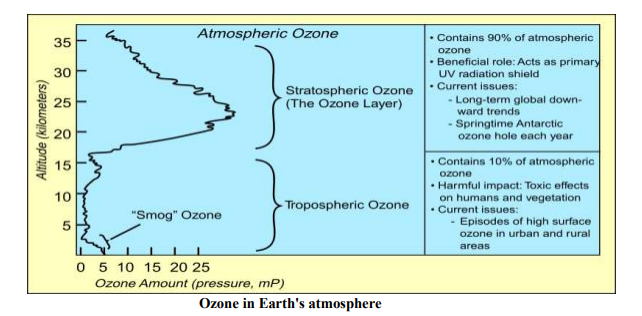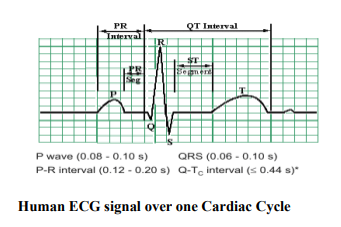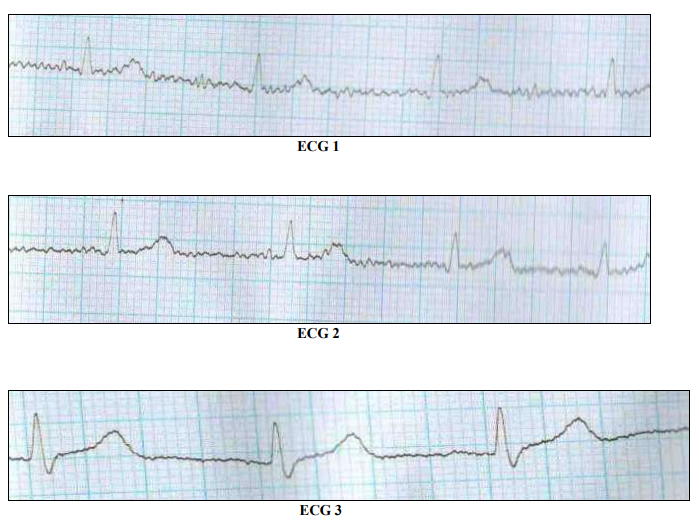IJCRR - 4(7), April, 2012
Pages: 149-154
Date of Publication: 18-Apr-2012
Print Article
Download XML Download PDF
EFFECT OF OZONE ON HUMAN ELECTROCARDIOGRAM
Author: Sonali S. Sakhare, B. H. Pawar
Category: Healthcare
Abstract:This paper presents the effect of ozone on the electrocardiogram. The electrocardiogram (ECG) is a test that records the electrical activity produced by the heart. The ECG can pick up abnormalities of heart rhythm and can give us information on whether the heart is enlarged or working under strain. Ozone thus plays a key role in the temperature structure of the Earth's atmosphere. We record the ECG of human being at normal conditions. After that person is seating inside the chamber. The temperature inside the chamber can be increased by heating lamp. Then long breathing can be carried out for ten minutes at higher temperature. Again record the ECG'S at higher temperatures. It is found that the Heart Rate becomes increases in higher temperatures.
Keywords: Electrocardiogram(ECG), heart rate, ozone.
Full Text:
INTRODUCTION
A. Ozone
Ozone is very rare in our atmosphere, averaging about three molecules of ozone for every 10 million air molecules. In spite of this small amount, ozone plays a vital role in the atmosphere. Ozone is mainly found in two regions of the Earth's atmosphere. Most ozone (about 90%) resides in a layer that bA. Ozoneegins between 10 and 17 kilometers above the Earth's surface and extends up to about 50 kilometers. This region of the atmosphere is called the stratosphere. The ozone in this region is commonly known as the ozone layer. The remaining ozone is in the lower region of the atmosphere, which is commonly called the troposphere. Ozone is a gas that forms in the atmosphere when 3 atoms of oxygen are combined (03). It is not emitted directly into the air, but at ground level is created by a chemical reaction between oxides of nitrogen (NO), and volatile organic compounds (VOC) in the presence of sunlight. Ozone has the same chemical structure whether it occurs high above the earth or at ground level and can be "good" or "bad," depending on its location in the atmosphere. The ozone molecules in the upper atmosphere (stratosphere) and the lower atmosphere (troposphere) are chemically identical, because they all consist of three oxygen atoms and have the chemical formula O3. However, they have very different roles in the atmosphere and very different effects on humans and other living beings. At the Earth's surface, ozone comes into direct contact with life-forms and displays its destructive side (hence, it is often called "bad ozone"). Because high levels of ozone are toxic to living systems. Stratospheric ozone (sometimes referred to as "good ozone") plays a beneficial role by absorbing most of the biologically damaging ultraviolet sunlight (called UV-B), allowing only a small amount to reach the Earth's surface. The absorption of ultraviolet radiation by ozone creates a source of heat, which actually forms the stratosphere itself (a region in which the temperature rises as one goes to higher altitudes). Ozone thus plays a key role in the temperature structure of the Earth's atmosphere.

B. Electrocardiogram (ECG)
The electrocardiogram (ECG) is a noninvasive test that is used to reflect underlying heart conditions by measuring the electrical activity of the heart. By positioning leads (electrical sensing devices) on the body in standardized locations, information about many heart conditions can be learned by looking for characteristic patterns on the ECG. An electrocardiogram can tell a lot about your heart and how it is working. A healthy person's electrocardiogram has a certain pattern. When there are changes in that pattern, then there is a problem with your heart. For example, during a heart attack, the EKG machine records the changing pattern of the heart's electrical activity.

C. Heart rate Heart rate is the number of heartbeats per unit of time, typically expressed as beats per minute (bpm). Heart rate can vary as the body's need to absorb oxygen and excrete carbon dioxide changes, such as during exercise or sleep. The measurement of heart rate is used by medical professionals to assist in the diagnosis and tracking of medical conditions. It is also used by individuals, such as athletes, who are interested in monitoring their heart rate to gain maximum efficiency from their training. The R wave to R heart rate (HR) is readily calculated from the ECG as follows: HR = 1,500/RR interval in millimeters, HR = 60/RR interval in seconds, or HR = 300/number of large squares between successive R waves. In each case, the authors are actually referring to instantaneous HR, which is the number of times the heart would beat if successive RR intervals were constant. However, because the above formula is almost always mentioned, students determine HR this way without looking at the ECG any further. Wave interval (RR interval) is the inverse of the heart rate.
MATERIALS AND METHODS
On detail history, all subjects were nonalcoholic, non-smokers, not taking any drug and were having similar dietary habits, physical and mental activities in working and home atmosphere. They were subjected to clinical examination and found healthy. Data on physical characteristics was obtained such as age, height, weight, diet, hemoglobin. The some normal human being where selected for study. ECG leads are attached to the body while the person lies flat on a bed or table. Leads are attached to pre-defined positions. A small amount of gel is applied to the skin, which allows the electrical impulses of the heart to be more easily transmitted to the ECG leads. First of all we record the ECG at normal condition. Then the person is seating inside the chamber. The temperature inside the chamber can be increased by heating lamp. The temperature can be measured by thermometer. Again record the ECG at higher temperature. Lastly interpret ECG in different conditions.
RESULTS
Present study was a case-control study. There were 15 subjects above 30 years of age of both sexes. Here we present result of two subjects. The first ECG recorded (shown in ECG 1) shows the normal ECG of First subject. He is vegetarian. The weight is fifty nine and hemoglobin is 11.5. The second ECG (shown in ECG 2) shows the effect Heart rate at high temperature. The third ECG recorded (shown in ECG 3) shows the normal ECG of second subject. He is vegetarian. The weight is fifty and hemoglobin is 12.5. The Fourth ECG (shown in ECG 4) shows the effect Heart rate at high temperature.

This shows tremendous change in ECG. In both the subject heart rate at higher temp goes on increases as compare to the normal ECG. Thus we have to maintain ozone level so that temperature in the atmosphere can be maintained.
DISCUSSION
To the best of our knowledge no study has been carried out showing effect of ozone on parameters at different temperature. Environmental conditions and variety of behavioral factors such as stress, anxiety, affective and attitudinal dispositions of the individual influence the cardiovascular responses. Ground-level ozone is created near the Earth's surface by the action of daylight UV rays on a group of pollutants called ozone precursors. There is a great deal of evidence to show that ground level ozone can harm lung function and irritate the respiratory system. Exposure to ozone and the pollutants that produce it is linked to premature death, asthma, bronchitis, heart attack, and other cardiopulmonary problems.
CONCLUSIONS
A number of investigations indicate that change in heart rate has emerged as a new risk factor for mortality in cardiovascular mortality in human beings. Ozone thus plays a key role in the temperature structure of the Earth's atmosphere. At different temperatures resulted in change in R-R interval that is Heart rate goes on changes. This can be avoided by maintain ozone level so that temperature in the atmosphere can be maintain.

References:
1. 1.Raju, PS, Anil Kumar K, Reddy SS, Madhavi S, Gnanakumari K, Bhaskaracharyulu C et al. Effects of yoga on exercise tolerance in normal healthy volunteers. Indian J Physiol Pharmacol 1986; 30:121-132..
2. Raju PS, Prasad KVV, Venkata Ramana Y, Murthy KJR, Reddy MV . Influence of intensive yoga training.
3. Tulpule TH, Tulpule AT. Indian Heart Journal 1980; 32(1): 1–7.
4. Nathan Physiological aspects of aging in man. Annu Rev Physiol 1961; 23:97–108.
5. Levin Albert B. A simple test of cardiac function based upon the heart rate changes influenced by the valsalva Maneuver. Am J Cardiol 1996 July; 18: 90–99.
6. Bowman AJ, Clayton RH, Murray A, Reed JW. Effects of aerobic exercise training and yoga on baroreflex in healthy elderly persons. Euro J ClinInvest 1997; 27(5): 443–449.
7. Shimada K et al. Effect of age and blood pressure on cardiovascular responses to valsalva maneuver.J Am Geriatr Soc 1986; 34(6): 431–434.
8. Ramakrishnan AG, Srinivasan TM, Fetzer JE: Significance of breathing pattern variabilityin HRV studies. Chinese society of Biomedical Engineering and InternationalFederation for Medical and Engineering. Beijing, China, 1993, pp 335.
9. Tanaka, Takehiko; Morino, Yonezo (1970). "Coriolis interaction and anharmonic potential function of ozone from the microwave spectra in the excited vibrational states". Journal of Molecular Spectroscopy 33 (3): 538–551.
10. Mack, Kenneth M.; Muenter, J. S. (1977). "Stark and Zeeman properties of ozone from molecular beam spectroscopy". Journal of Chemical Physics 66 (12): 5278–5283.
|






 This work is licensed under a Creative Commons Attribution-NonCommercial 4.0 International License
This work is licensed under a Creative Commons Attribution-NonCommercial 4.0 International License